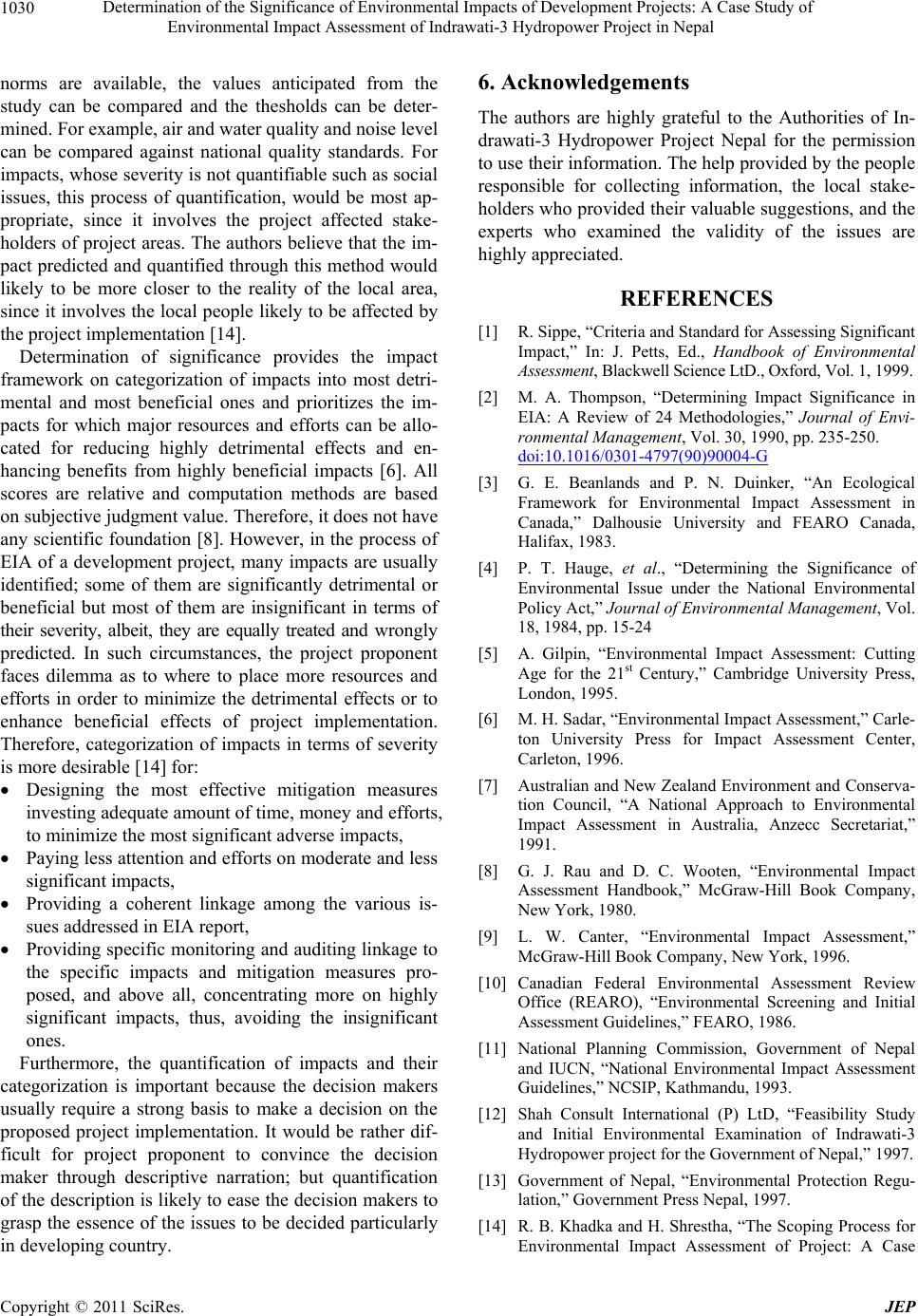
Determination of the Significance of Environmental Impacts of Development Projects: A Case Study of
Environmental Impact Assessment of Indrawati-3 Hydropower Project in Nepal
1030
norms are available, the values anticipated from the
study can be compared and the thesholds can be deter-
mined. For example, air and water quality and noise level
can be compared against national quality standards. For
impacts, whose severity is not quantifiable such as social
issues, this process of quantification, would be most ap-
propriate, since it involves the project affected stake-
holders of project areas. The authors believe that the im-
pact predicted and quantified through this method would
likely to be more closer to the reality of the local area,
since it involves the lo cal people likely to be affected by
the project implementation [14].
Determination of significance provides the impact
framework on categorization of impacts into most detri-
mental and most beneficial ones and prioritizes the im-
pacts for which major resources and efforts can be allo-
cated for reducing highly detrimental effects and en-
hancing benefits from highly beneficial impacts [6]. All
scores are relative and computation methods are based
on subjective judgment value. Therefore, it does not have
any scientific foundation [8]. However, in the process of
EIA of a development project, many impacts are usually
identified; some of them are significantly detrimental or
beneficial but most of them are insignificant in terms of
their severity, albeit, they are equally treated and wrongly
predicted. In such circumstances, the project proponent
faces dilemma as to where to place more resources and
efforts in order to minimize the detrimental effects or to
enhance beneficial effects of project implementation.
Therefore, categorization of impacts in terms of severity
is more desirable [14] for:
Designing the most effective mitigation measures
investing adequate amount of time, money and efforts,
to minimize the most significant adverse impacts,
Paying less attention and efforts on moderate and less
significant impacts,
Providing a coherent linkage among the various is-
sues addressed in EIA report,
Providing specific monitoring and aud iting linkage to
the specific impacts and mitigation measures pro-
posed, and above all, concentrating more on highly
significant impacts, thus, avoiding the insignificant
ones.
Furthermore, the quantification of impacts and their
categorization is important because the decision makers
usually require a strong basis to make a decision on the
proposed project implementation. It would be rather dif-
ficult for project proponent to convince the decision
maker through descriptive narration; but quantification
of the description is likely to ease the decision makers to
grasp the essence of the issues to be decided particularly
in developing country.
6. Acknowledgements
The authors are highly grateful to the Authorities of In-
drawati-3 Hydropower Project Nepal for the permission
to use their information. The help prov ided by the people
responsible for collecting information, the local stake-
holders who provided their valuable suggestions, and the
experts who examined the validity of the issues are
highly appreciated.
REFERENCES
[1] R. Sippe, “Criteria and Standard for Assessing Significant
Impact,” In: J. Petts, Ed., Handbook of Environmental
Assessment , Bla c k wel l Sci ence L t D., O xfo r d , V ol. 1, 1999.
[2] M. A. Thompson, “Determining Impact Significance in
EIA: A Review of 24 Methodologies,” Journal of Envi-
ronmental Management, Vol. 30, 1990, pp. 235-250.
doi:10.1016/0301-4797(90)90004-G
[3] G. E. Beanlands and P. N. Duinker, “An Ecological
Framework for Environmental Impact Assessment in
Canada,” Dalhousie University and FEARO Canada,
Halifax, 1983.
[4] P. T. Hauge, et al., “Determining the Significance of
Environmental Issue under the National Environmental
Policy Act,” Journal of Environmental Management, Vol.
18, 1984, pp. 15-24
[5] A. Gilpin, “Environmental Impact Assessment: Cutting
Age for the 21st Century,” Cambridge University Press,
London, 1995.
[6] M. H. Sadar, “Environmental Impact Assessment,” Carle-
ton University Press for Impact Assessment Center,
Carleton, 1996.
[7] Australian and New Zealand Environment and Conserva-
tion Council, “A National Approach to Environmental
Impact Assessment in Australia, Anzecc Secretariat,”
1991.
[8] G. J. Rau and D. C. Wooten, “Environmental Impact
Assessment Handbook,” McGraw-Hill Book Company,
New York, 1980.
[9] L. W. Canter, “Environmental Impact Assessment,”
McGraw-Hill Book Company, New York, 1996.
[10] Canadian Federal Environmental Assessment Review
Office (REARO), “Environmental Screening and Initial
Assessment Guidelines,” FEARO, 1986.
[11] National Planning Commission, Government of Nepal
and IUCN, “National Environmental Impact Assessment
Guidelines,” NCSIP, Kathmandu, 1993.
[12] Shah Consult International (P) LtD, “Feasibility Study
and Initial Environmental Examination of Indrawati-3
Hydropower project for the Government of Nepal,” 1997.
[13] Government of Nepal, “Environmental Protection Regu-
lation,” Government Press Nepal, 1997.
[14] R. B. Khadka and H. Shrestha, “The Scoping Process for
Environmental Impact Assessment of Project: A Case
C
opyright © 2011 SciRes. JEP